 |

 |
| Advertisements |

|
|
 |
How to Do Business in Sweden and Finland
By Ralph McElroy,
McElroy Translation,
Austin, Texas 78701 USA
quotes[at]mcelroytranslation.com
http://www.mcelroytranslation.com/
Become a member of TranslationDirectory.com at just
$12 per month (paid per year)
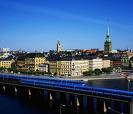 A
recent request from a client: A
recent request from a client:
Shelly - If you have any book (or film or Web site or other) suggestions
re. “Optimizing presenting to non-American audiences, for Americans,”
I’d welcome any tips.
I have gigs in Sweden in May (audience of lawyers from all over the world,
but probably mainly mixed Europeans) and Finland in June (businesspeople and
academics Finns).
I’ve spoken in Budapest and Prague, and am a futboler (soccer player),
but always try (like any good musician) to “improve my chops.” Thanks.
Language
- The four major Scandinavian languages - Danish, Swedish, Norwegian and Icelandic
- are closely related.
- Finnish, on the other hand, is not a Germanic language, and is completely different
from the others. While a Swede and a Dane often understand each other fairly
well in a conversation, neither of them would understand Finnish.
- Finnish belongs to the tiny Finno-Ugrian language family; outside Finland it
is only understood (and to some extent spoken) in Estonia.
- One of the minority languages, Sami, is spoken by Sweden’s oldest ethnic
minority, the Sami. This ethnic group also exists in Finland.
- There are fairly large minorities of Swedes and Finns in each other’s
countries.
- English is taught as a compulsory secondary language in Swedish schools. English
is also learned to a large extent through TV, music, and films. It is also widely
spoken in Finland.
Religion
- Sweden - To generalize on a wider geographical scale, one could perhaps say
that Scandinavians share a Lutheran past, a present state of religious indifference,
as well as the idea that the church still has an important part to play in the
major events of life. www.smorgasbord.
- Finland - In spite of a thousand-year Christian tradition, thanks to which most
Finns even today belong to the Lutheran church, many holidays maintain vestiges
of old Finnish pagan traditions. Notable among these is the Finnish Midsummer
festival, Juhannus, that involves burning a large bonfire and drunken revelry.
Swedish Food
 Sweden
is one of the heaviest coffee drinking countries in the world, second only
to Finland. Saying no to a cup of coffee is almost considered rude in Sweden. Sweden
is one of the heaviest coffee drinking countries in the world, second only
to Finland. Saying no to a cup of coffee is almost considered rude in Sweden.
- Milk consumption in Sweden is the highest of any country in the world.
- Breakfast usually consists of open sandwiches, possibly crisp bread (knäckebröd).
The sandwich is most often buttered, with toppings such as hard cheese, cold
cuts, caviar, or messmör. Filmjölk (fermented milk), or sometimes
yogurt, is also traditional breakfast food, usually served in a bowl with
cereals such as corn flakes, muesli, or knäckebröd, and sometimes
with sugar, fruit, and/or jam.
- Typical Swedish fast-food - hot-dog stand (korvkiosk). There you can choose
between fried and boiled hot dogs, served with French fries or mashed potatoes
together with mustard and/or ketchup (Senap eller ketchup? You will be asked).
Lately, some new dishes have turned up in the stands, like baked potatoes.
- Husmanskost, good old everyday food based on classic country cooking; Strömming
= Baltic herring; Lingonberry jam is still popular.
- For Swedish home fare you can try pea soup with pork and pancakes for dessert.
This dish is usually served on Thursdays and if you want to go the whole hog
you should order some Swedish punch for the pancakes, a yellow and very sweet
alcoholic beverage, usually served ice-cold. Or try Pytt i panna, a hash of
fried diced meat with onions and potatoes.
- An average Smorgasbord may, for instance, contain a number of herring dishes
(sweet-pickled herring, pickled herring with onions, mustard, dill, etc.),
Swedish meatballs (köttbullar), salmon, pies, salads, "Jansson´s
temptation" (sliced herring, potatoes and onions baked in cream), eggs, bread,
boiled and fried potatoes and so on.
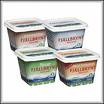 Sweetness
is a prominent characteristic of Swedish bread, although unsweetened types
are available in most stores. If you want to spread something typically Swedish
on a slice of bread, try messmör, which is a soft whey-cheese from the
north of Sweden. It is quite sweet, too! Sweetness
is a prominent characteristic of Swedish bread, although unsweetened types
are available in most stores. If you want to spread something typically Swedish
on a slice of bread, try messmör, which is a soft whey-cheese from the
north of Sweden. It is quite sweet, too! - In August, Swedes traditionally eat boiled crayfish at feasts known as kräftskivor.
- Watch out for Surströmming (sour or pickled herring), a northern Swedish
delicacy consisting of fermented Baltic herring. Surströmming is sold
in cans, which when opened release a strong, foul smell. It is for this particular
smell, which is similar to fish gone bad or garbage left out in the sun for
a couple of days, that surströmming is infamous in popular culture.
Alcohol
- Most Swedes have zero tolerance against
drunkenness at work and in traffic. Drinking during lunchtime in workdays
- even one beer - is taboo, and a public official sentenced for drunk
driving is usually expected to resign. Most drinking takes place on weekends and during
holidays.
- Swedish beer is divided into classes according
to its alcohol content. There are class I (lättöl), class II
(folköl) and class III (starköl) beers with a class I beer being
the weakest and a class III beer being the strongest beer. Class I and II
beers are available in supermarkets, whereas class III is only on sale in
licensed shops (Systembolaget) or pubs, bars and restaurants. One of the
biggest beer breweries in Sweden is Pripps.
- A snaps is usually brännvin (which may be
vodka such as Absolut or Explorer, or akvavit), but can also be some other
light-bodied spirit, as long as it isn't sweet. Major Scandinavian brands
of snaps include: Swedish "O P Andersson," Norwegian "Linie Akvavit" and
Danish "Aalborg."
Swedish
Literature, Writers and The Nobel Prize
 Swedish
people read a lot. Each year, about 65 million books are borrowed at public
libraries. Swedish
people read a lot. Each year, about 65 million books are borrowed at public
libraries. - Sweden ranks third in the list of countries with the most Nobel Prize
laureates in literature.
- Famous Swedish authors: Astrid Lindgren, Selma Lagerlöf, Harry Martinson,
Ivar Lo-Johansson, August Strindberg, Vilhelm Moberg, Pär Lagerkvist
and Astrid Lindgren.
- The Nobel Prizes: first given in 1901, are presented to the Laureates
at ceremonies on December 10 each year. Alfred Nobel (1833-1896) was the inventor
of dynamite. The five prizes: Chemistry, Physics, Medicine, Physiology, Literature
and the Peace Prize. In 1968, Sveriges Riksbank (The Swedish National Treasury)
established a prize for economic science.
Swedish Music and Film
- Music - www.smorgasbored.com
- List of hip-hop artists: www.en.wikipedia.org
- Singing is popular in Sweden, and of its 9,000,000 inhabitants, 600,000 belong to various choirs.
- They also boast one of the most prolific death
metal scenes in the world. Gothenburg is famed in the scene for the
"Swedish Death" sound. Many of these bands such as In Flames, Dark
Tranquility, and Stockholm's Opeth have seen growing commercial success throughout
Europe and the US.
- Famous actresses and actors include Ingrid
Bergman, Greta Garbo, Max von Sydow, Stellan Skarsgård, Ingrid
Thulin, Lena Olin and Peter Stormare.
- Ingmar Bergman, regarded as one of the most
influential filmmakers of the 20th Century
Swedish Art, Design & Architecture
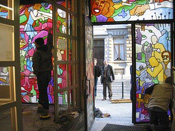 A
characteristic feature of the Swedish arts scene is the large number of art
associations (about 1800). Most of them are formed by art-loving employees
at companies or institutions. A
characteristic feature of the Swedish arts scene is the large number of art
associations (about 1800). Most of them are formed by art-loving employees
at companies or institutions. - Sweden was one of the strongholds of the Functional movement. The ideas
of the Functionalist movement can still be found in the profile of the IKEA
company.
- Its breakthrough can be dated back to the Stockholm Exhibition in 1930,
which was conceived by architect Gunnar Asplund and "the ideologist" Gregor
Paulsson.
- About 1,500 of Sweden's 4,000 churches date to the Middle Ages.
- Vasa (Wasa) castles - Gripsholm Castle, Kalmar Castle and Vadstena Castle
- massive walls and with a fusion of medieval elements and Renaissance architecture.
Built starting with the reign of Gustav Vasa, King of Sweden from 1523; labeled
the founder of modern Sweden.
- The production of tiled stoves in Sweden was resumed in 1980 at the Gustavsberg
porcelain factory.
- In the province of Dalarna the old tradition of woodcarving has become
a tourist industry, the most famous product of which is the gaudily painted
Dalecarlian horse.
- The glassworks Kosta and Orrefors are famous for their crystal vases and
glasses. They are situated in "The Glass Kingdom," an area in the southeast
of the Småland province.
- The most renowned Swedish painters from the 19th and 20th centuries are
Anders Zorn, Carl Larsson and Bruno Liljefors; Carl Milles is Sweden's internationally
best known sculptor.
- Bruno Mattson, furniture designer and architect, became famous in world
exhibitions in Paris in 1937 and in New York in 1939. Since 1978 the furniture
factory DUX makes his classical furniture, for example the "relaxing-chair"
Pernilla and the "working- chair" Eva. www.scandinaviandesign.com
- IKEA is privately held, founded in Älmhult , Sweden by Ingvar Kamprad,
in 1943 who was then 17. It is owned by a Dutch-registered foundation controlled
by the Kamprad family. IKEA is an acronym comprising the initials of the founder's
name, Ingvar Kamprad, and home village, Elmtaryd, Agunnaryd. It has 253 stores
in 35 countries; IKEA is one of the few store chains to have locations both
in Israel and in other Middle East nations. The company motto is: "Affordable
Solutions for Better Living."
Misc
- Swedish weeks begin on Mondays.
- Most retail stores, at least in cities, are
open all week.
- Most Swedish children are allowed to eat sweets
only on Saturdays - lördagsgodis.
- The minimum vacation each year is five weeks,
and most Swedes take all of July off - the "industrial vacation."
- The Swedish people are concerned about the
environment and animal protection. Swedish farmers actively advertise
their products as free from genetic engineering, cruelty against animals,
un-organic chemicals and excessive transportation.
- Rinkeby Swedish (Rinkebysvenska) is a common
term for varieties of Swedish spoken mainly in suburbs with a high
proportion of immigrants and immigrant descendants. It has a simplified
version of the Swedish grammar and a richness of loanwords from the
languages the speakers' parents or grandparents originated in: mainly
Turkish, with traces of Kurdish, Arabic, Greek, Persian, Serbo-Croatian,
Assyrian Neo-Aramaic, and to some extent Latin American Spanish. There is
also an influx of English words and grammar due to a fairly common
identification with African Americans and the appreciation of rap and hip
hop music and culture.
Other Etiquette
- In some restaurants or clubs, it is mandatory
to deposit your coat. It costs 15Kn per piece.
- You do not have to tip taxi drivers.
- When visiting someone's house in Sweden (and other Scandinavian countries) you take off your shoes when entering their
house.
Göteborg (Gothenburg),
Sweden
 Population
- 490,000 in the actual city and 879,000 in the metropolitan area, making
it the second largest city in Sweden, after Stockholm. Population
- 490,000 in the actual city and 879,000 in the metropolitan area, making
it the second largest city in Sweden, after Stockholm. - By 2005, there were 93,965 immigrants resident in Gothenburg, which is
about 20% of the population, out of which 10% are from Iran and 9% from Finland.
- Most important city for trade and industry with several well known international
companies: Astra Zeneca, Ericsson Microwave Systems, Esab, SCA Moelnlycke,
Nobel Biocare, Saab Ericsson Space, SKF, Stena Line, Hasselblad, and Volvo.
More than 150 pharmaceutical and biotechnology companies are located in the
Göteborg region.
- There are two universities in Gothenburg: Gothenburg University and the
Chalmers University of Technology. Today there are more than 60,000 students,
which makes Gothenburg the largest university city in Scandinavia.
- Gothenburg has hosted both the World Cup and European championships in
football, as well as World and European championships in Athletics, World
Championship in ice hockey and handball. The most famous club in the city,
and in Sweden, is IFK Gothenburg. They have won the Swedish league 17 times,
although the latest title came back in 1996. The Swedish season goes from
April to the beginning of November. IFK Gothenburg colors are blue and white.
- List of restaurants and things to do: www.goteborg.com
Or try Saluhallen, the food hall at Kungstorget. It gets rave reviews for
all the types of food you can get very inexpensively. Alexandra's is especially
noted.
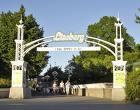 The
biggest attraction in the city is the amusement park Liseberg. The
biggest attraction in the city is the amusement park Liseberg. - The city is also noted for being the centre of the melodic death metal
movement (sometimes even called "The Gothenburg sound"). Gothenburg metal
is unique and distinct because of its very melodic and sometimes progressive
guitar riffs and solos, and the clean singing that is incorporated (instead
of just using the traditional death grunt vocals). Gothenburg's own At the
Gates, Soilwork, In Flames, and Dark Tranquility are credited with pioneering
this melodic style. The Gothenburg metal has influenced numerous significant
metal scenes across Europe and the rest of the world, including Finland, the
United States, and Canada.
- Sister cities: Chicago, United States (since 1987), Kraków, Poland,
Saint Petersburg, Russia, Tallinn, Estonia, Rostock, Germany
- In Swedish “G” is pronounced as “ye," making Göteborg sound
something like “yoe-te-bor."
Göteborg History,
Etc.
- Named related to ancient tribe Geats (also Goths),
made famous in Beowulf. In this heroic epic poem, a hero of a Germanic
tribe from southern Sweden called the Geats travels to Denmark to help defeat a monster named Grendel.
- Permanent settlement founded in 1621 by King
Gustavus Adolphus (Gustaf II Adolf).
- The town was planned according to Dutch
concepts, with canals and fortifications.
- Gothenburg, Nebraska was founded in 1882
by Olof Bergstrom and is named for Göteborg, Sweden.
- Göteborg is situated on the western coast by Kattegatt, an arm of
the North Sea, at the outlet of the river Göta älv and the Göta
Canal (satellite view: en.wikipedia.org.
Finnish Food
- #1 in coffee consumption. Short article on history of coffee in Finland:
http://users.tkk.fi/~untamo/file2.doc.html
- Finnish dishes tend to be less sweet than
Swedish ones, and Finns use less sour cream (smetana) in preparation than
their Russian neighbors.
- Breakfast usually consists of open sandwiches,
often buttered (with margarine) and with toppings such as hard cheese or
cold cuts. Finns usually do not have sweets on their breads; sour milk
products such as Yogurt or viili are also common breakfast foods, usually
served in a bowl with cereals such as corn flakes, muesli, and sometimes
with sugar, fruit or jam. A third food that is commonly eaten at breakfast
is porridge (puuro), often made of rolled oats, and eaten with a pat of
butter (voisilmä, lit. "butter eye") and/or with milk, or fruit or
jam, especially the sort made of lingonberries.
- Karelian pasties - typically a thin rye crust
with a filling of rice. Butter, often mixed with boiled egg (eggbutter or
munavoi), is spread over the hot pasties before eating.
- Cabbage rolls - filling usually includes meat,
often beef, lamb or pork, seasoned with onion, tomato paste, salt, black
pepper, and spices; normally baked in oven and brushed with dark syrup and
traditionally served with bitter lingonberry jam or fresh lingonberries.
- As in Sweden, there is a tradition of serving
pea soup on Thursdays.
Alcohol
- Koskenkorva Viina (also known simply as Koskenkorva, or Kossu) is the
most common clear spirit drink (38%) in Finland. The grain (barley) alcohol
is produced using a 200-step continuous distillation designed to produce high-purity
industrial ethanol. The drink is produced by diluting this alcohol with spring
water and a very small amount of sugar. It is not a true vodka, and is never
called such in Finnish. Instead, it is viina, simply “hard liquor," often
used contextually similarly to the word “booze." There are several flavored
variants of Koskenkorva on the market.
 Sahti
is a traditional beer from Finland. Traditionally the beer is flavored with
juniper berries in addition to, or instead of, hops; the mash is filtered
through juniper twigs through a tun called a kuurna in Finnish. Sahti has
a distinct banana flavor due to the carbohydrate contents. Sahti
is a traditional beer from Finland. Traditionally the beer is flavored with
juniper berries in addition to, or instead of, hops; the mash is filtered
through juniper twigs through a tun called a kuurna in Finnish. Sahti has
a distinct banana flavor due to the carbohydrate contents. - Lakka or Lakkalikööri is a liqueur produced in Finland which
derives its flavor from the cloudberry fruit. The beverage is produced by
soaking the berries in alcohol anywhere between two to six months until sweetened.
The liqueur can be drunk as it is, but is also often mixed with hot coffee.
- In Finland, a sweet mead called Sima (cognate with zymurgy) is still an
essential seasonal brew connected with the Finnish Vappu (May Day) festival.
It is usually spiced by adding lemon. During secondary fermentation raisins
are added; they rise to the top of the bottle when the drink is ready.
Finnish Literature,
Writers
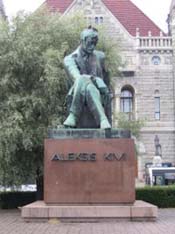 Without
a long literary history, Elias Lönnrot collected Finnish and Karelian
folk poetry and arranged and published them as Kalevala, the Finnish national
epic. The era saw a rise of poets and novelists who wrote in Finnish, notably
Aleksis Kivi. Without
a long literary history, Elias Lönnrot collected Finnish and Karelian
folk poetry and arranged and published them as Kalevala, the Finnish national
epic. The era saw a rise of poets and novelists who wrote in Finnish, notably
Aleksis Kivi. - Famous modernist writer - Mika Waltari; 1945 saw the publication of Waltari's
first and most successful historical novel, The Egyptian. Its theme of the
corruption of humanist values in a materialist world seemed curiously topical
in the aftermath of World War II, and the book became an international bestseller,
serving as the basis of the 1954 Hollywood movie of the same name.
- Väinö Linna - his social realism had a profound influence in
Finnish social, political and cultural life; more than 300,000 copies of Tuntematon
Sotilas, a realistic war novel, have been sold in a country with a population
of 4 million; the film by Edvin Laine is broadcast by the national television
every Day of Independence (Dec. 6). For decades this novel has been mandatory
reading in military academies.
- Ranya El Ramly wrote a much praised, award-winning debut novel Auringon
asema (2002; The Position of the Sun).
- Detective stories are enjoying a particular boom of popularity.
Finnish Music, Theater
- Modern Finnish popular music has received
attention also in foreign countries, especially on the rock and metal
scenes, with such bands as The Rasmus, HIM, Nightwish and Stratovarius
gaining international acclaim.
- The Jyväskylä Arts Festival, which is
the oldest on-going summer festival in Scandinavia, concentrates on
non-verbal theater.
- Jean Sibelius was one of Finland's greatest
composers. It is no wonder that Sibelius' compositions are full of the
natural vigor of the forests; once he even took a grand piano with him in
the midst of forests and hills of Koli.
- The Kantele - Finland's national instrument: http://virtual.finland.fi/netcomm/news/showarticle.asp?intNWSAID=27002
Finnish Art, Design
& Architecture
- Jyväskylä's favorite son, the
architect Alvar Aalto, is widely regarded as one of the great innovators
in western architecture. The Alvar Aalto Museum and the numerous buildings
designed by Aalto constantly bring to Jyväskylä professionals
and amateurs in the field of architecture from all over the world.
- Artists who inspired a sense of national
identity: Akseli Gallen-Kallela with his paintings, Pekka Halonen, who
became renowned for his paintings depicting the forest in winter, and Eero
Järnefelt, whose paintings made Koli into the epitome of the Finnish
heritage landscape; I.K. Inha with his photographs, and Eliel Saarinen
with his architecture and banknote illustrations.
- The reputation of Finnish design has also
helped young designers with their internationalization. The rise of the
University of Art and Design to become one of Europe's leading colleges of
its kind has greatly supported this trend.
- The three strong sectors of Finnish industry -
forest products, metal and electronics - have rapidly expanded the role of
industrial design and increased its share of the field of design.
Other Etiquette
- Tips are not expected - service is always
included. If you feel you have received excellent service or someone
really has gone out of their way to help you in a taxi or in a restaurant,
feel free to tip - the recipient is normally pleased. But if your tip is declined,
don't push it...
Miscellaneous
- Became EU member in 1995, uses the Euro,
neither Sweden or Finland are members of NATO.
- Finland's foreign community, only 2% of the
population, is very small in comparison with other European countries but
it is growing. They
are mostly from the former Soviet Union.
- Families with children are especially well
taken care of by society, and their lives are made easier by the many
types of support and benefits available.
- The world's most renowned travel publisher, Lonely Planet, has listed Finland
as one of the 10 countries to visit in 2007: www.visitfinland.com
- Finnish summer 2007 brochure: www.visitfinland.com
- Santa Claus Village is situated 8 km north of Rovaniemi. Santa Claus' Office is right near the Arctic Circle in Finnish Lapland.
- For most of its history, Finland was ruled by
another country. For about 500 years, Finland's neighbor to the west,
Sweden, ruled it. And for another hundred years, Finland's neighbor to the
west, Russia, ruled it.
Jyväskylä, Finland
 Located
in the lake district of Central Finland, it is celebrating its 170th birthday
on the 22nd of March 2007 - for one whole week. Located
in the lake district of Central Finland, it is celebrating its 170th birthday
on the 22nd of March 2007 - for one whole week. - 80,000 inhabitants. The Jyväskylä region - comprising of the
city of Jyväskylä and 9 municipalities - has over 160,000 inhabitants.
- It is a school and university town with 39 000 students.
- The landscape of Jyväskylä is varied with lakes, forests and
hills within walking distance of the city center.
- An important incubator for new business and companies is the Jyväskylä
Science Park, combining newest research and development to the needs of business
life. The Human Technologies Centre Agora focuses on developing human-centered
information technology and creates new kind of interaction between high-level
research, education, enterprises, and the local community.
References
used
Business
in Sweden: www.buyusa.gov
Swedish
Etiquette: www.ediplomat.com
Business
in Finland: www.buyusa.gov
Finnish
Etiquette: www.virtual.finland.com
More
info: www.kwintessential.com.uk
Finnish
sauna etiquette: www.disabled-world.com
Useful
info: www.centralfinland.com
Submit your article!
Read more articles - free!
Read sense of life articles!
E-mail
this article to your colleague!
Need
more translation jobs? Click here!
Translation
agencies are welcome to register here - Free!
Freelance
translators are welcome to register here - Free!
|
 |
 |
| Free
Newsletter |
 |
|
|
|
 |



 A
recent request from a client:
A
recent request from a client: